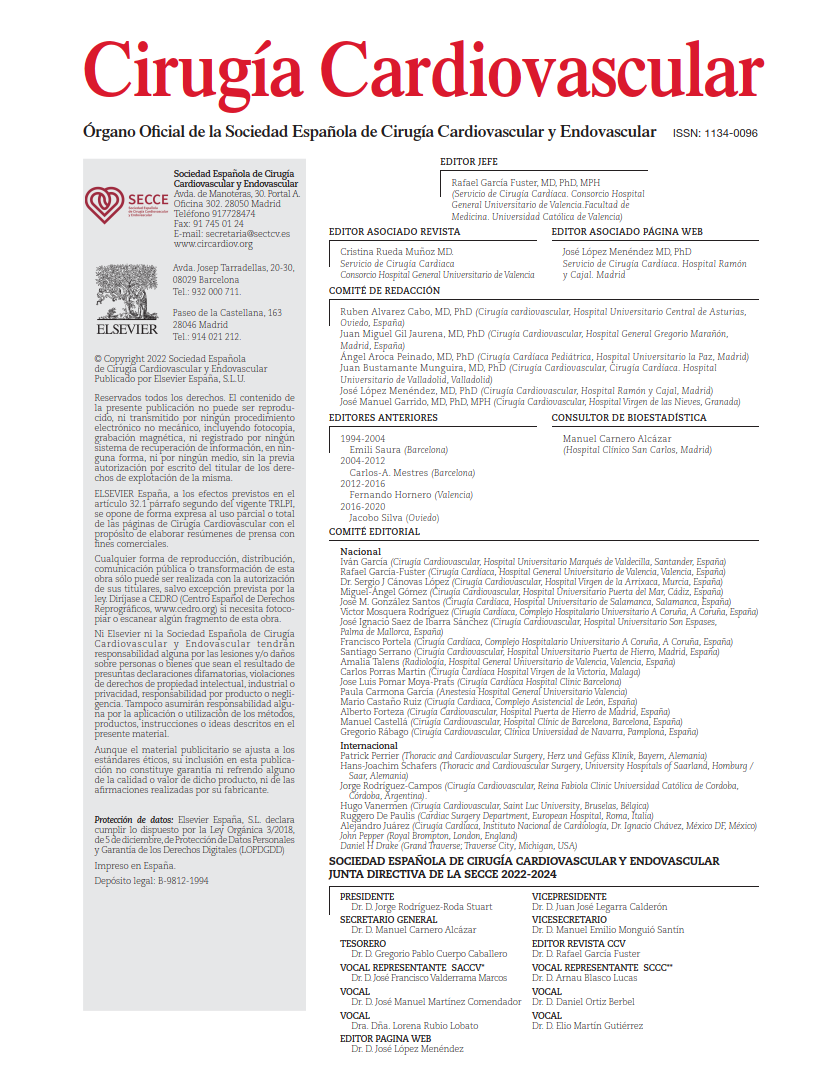Cardiopulmonary bypass has long been a cornerstone of cardiac surgery, enabling the development of complex procedures to treat most of the diseases in the specialty. Since its first application by John Gibbon over 70 years ago, technological advances have improved its efficiency, effectiveness, and safety. However, CPB is known to be associated with a range of adverse effects, notably the systemic inflammatory response, which can lead to metabolic disturbances and multiorgan dysfunction.
Given the immune dysregulation and cytokine surge triggered by CPB, several studies have explored its short-, mid-, and long-term implications, including the potential oncologic consequences. Among the most notable are a post hoc analysis of the MASS II trial by Vieira et al., and cohort studies by Alameddine et al. and Pinto et al. Particularly relevant is Pinto’s work, involving 43,347 patients undergoing CABG—with or without CPB—over a 7-year follow-up period. All three studies proposed a possible link between CPB use in cardiac surgery and increased cancer risk.
The current study offers new insights, challenging those earlier conclusions. It analyzed a large Swedish cohort of 81097 patients aged over 18 years who underwent isolated first-time CABG between 1997 and 2020: 77,345 with CPB and 3752 off-pump. Patients with a prior history of cancer or who died before discharge were excluded. The primary endpoint was time from surgery to the first cancer diagnosis. Data were derived from the SWEDEHEART registry and four additional national databases. Adjustments were made for demographic, clinical, socioeconomic, and surgical variables using multivariable Cox regression and propensity score matching (PSM).
The median follow-up was 8.9 years in the CPB group and 12.2 years in the off-pump group. A total of 21006 cancer events occurred (19,815 with CPB and 1191 without). The most common cancer sites were, in descending order: skin (27.5%), male genital system (22.0%), digestive system (14.7%), urinary system (8.0%), unspecified (7.8%), and respiratory tract (6.6%). Proportions by cancer location were similar in both groups.
The overall cancer incidence rate was 2.71 per 100 person-years in the CPB group and 2.68 in the off-pump group (aHR = 0.95; p = .12). Similar results were found after propensity score matching: 2.57 vs 2.68, respectively (aHR = 0.96; p = .36). Cancer-specific mortality rates were also comparable: 0.77 vs 0.76 per 100 person-years (aHR = 0.99), with no significant difference even after PSM (aHR = 0.98).
In summary, the adjusted multivariable analyses showed no statistically significant differences in long-term cancer incidence or mortality between the two surgical approaches. The authors conclude that the use of CPB during CABG does not confer an increased risk of developing or dying from cancer.
COMMENTARY:
Cardiopulmonary bypass remains an indispensable ally in cardiac surgery. Without it, the specialty could not have evolved to its current level of complexity and therapeutic reach. Like many medical interventions, it is not without adverse effects. For this reason, both clinicians and patients must continuously weigh risks and benefits, relying on robust evidence interpreted with critical judgment.
One of the strengths of this study is its large sample size and the reliability of the national data sources, which provide solid ground for interpreting the results and addressing questions about the potential oncological impact of CPB.
Nonetheless, the study’s internal validity may be challenged by the marked imbalance between the two groups: the vast majority underwent CABG with CPB. This reflects not only local practice patterns but also global trends favoring on-pump surgery. Such imbalance introduces potential bias, which may persist despite statistical adjustment methods like propensity score matching. Moreover, while the authors mention the primary endpoint as the time from surgery to cancer diagnosis, this key parameter is not explicitly reported, which may affect the clarity and transparency of the results.
Despite the inherent limitations of any observational design, this study contributes new and valuable evidence to the existing literature and questions prior findings that suggested an oncological risk associated with CPB. A logical next step would be to design a randomized controlled trial capable of definitively testing this association with higher methodological rigor and reduced bias.
Until such evidence becomes available, it remains crucial to provide appropriate long-term follow-up after hospital discharge. Multidisciplinary and individualized approaches should aim to ensure continuous surveillance and control of cardiovascular risk factors—particularly those involved in chronic inflammation, such as smoking, diabetes mellitus, hypertension, dyslipidemia, and metabolic syndrome. This would lay the foundation for an effective strategy to prevent, detect early, and treat conditions linked to these predisposing factors or to the procedures themselves.
REFERENCE:
Mennander A, Nielsen SJ, Skytta T, Landenhed Smith M, Martinsson A, Pivodic A et al. Long-term risk for incident cancer in patients undergoing coronary artery bypass grafting with or without cardiopulmonary bypass: a nationwide population-based study. Eur J Cardiothorac Surg 2025; doi:10.1093/ejcts/ezaf110.
Vieira RD, Pereira AC, Lima EG, Garzillo CL, Rezende PC, Favarato D, et al. Cancer-related deaths among different treatment options in chronic coronary artery disease: results of a 6-year follow-up of the MASS II study. Coron Artery Dis. 2012;23(2):79–84. doi:10.1097/MCA.0b013e32834f112a
Alameddine AK, Visintainer P, Normand SLT, Wolf RE, Alameddine YA. Cancer rates in adults after cardiac interventions: a preliminary observational report. Am J Clin Oncol. 2014;00(00):1–3. doi:10.1097/COC.0000000000000120
Pinto CA, Marcella S, August DA, Holland B, Kostis JB, Demissie K. Cardiopulmonary bypass has a modest association with cancer progression: a retrospective cohort study. BMC Cancer. 2013;13:519. doi:10.1186/1471-2407-13-519



